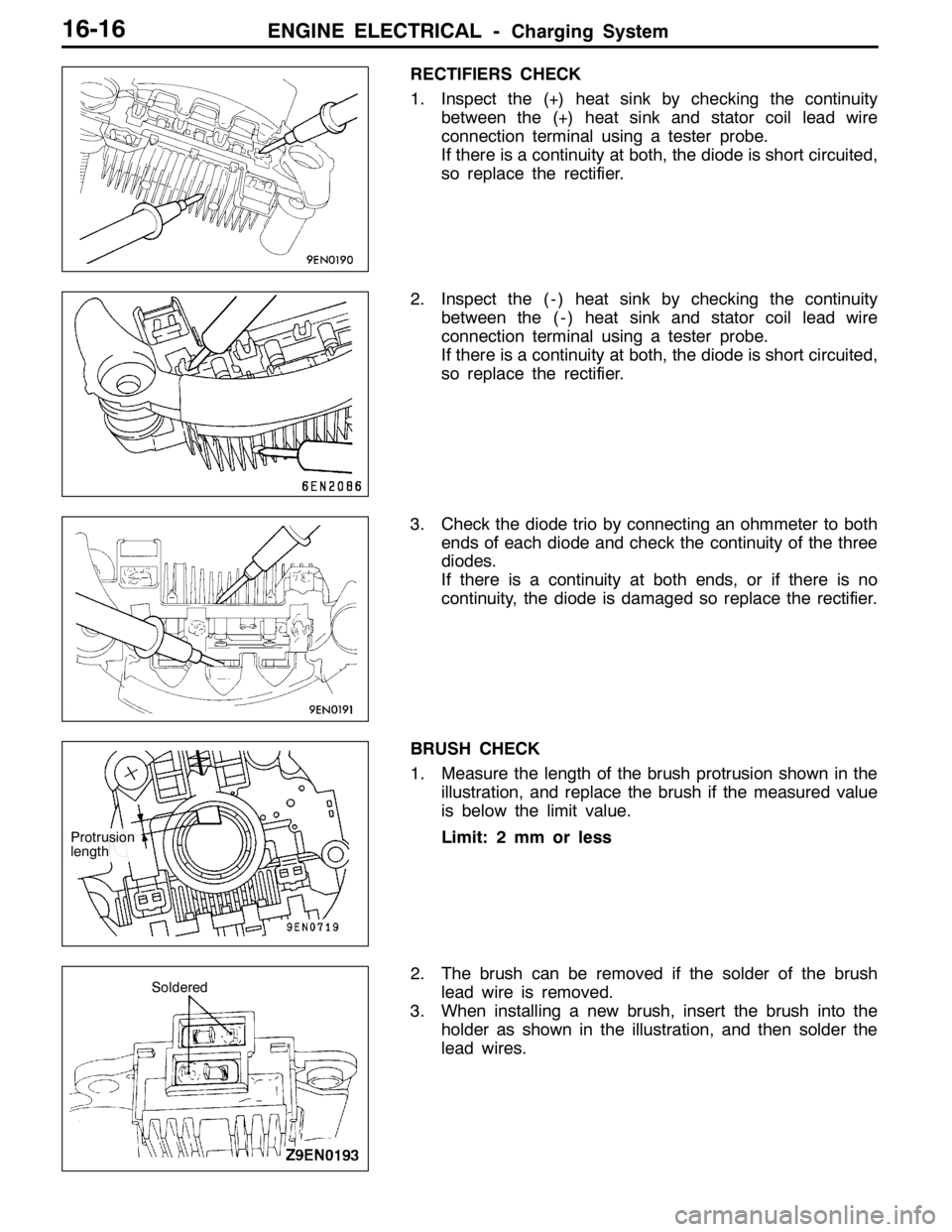Page 747 of 1449
ENGINE ELECTRICAL -Charging System16-15
"BAROTOR INSTALLATION
After installing the rotor, remove the wire used to fix the brush.
INSPECTION
ROTOR CHECK
1. Check the continuity between the rotor coil slip rings,
and replace the rotor if the resistance value is not at
the standard value.
Standard value: 3 - 5Ω
2. Check the continuity between the slip ring and core, and
if there is continuity, replace the rotor.
STATOR CHECK
1. Check the continuity between the coil leads, and if there
is continuity, replace the stator.
2. Check the continuity between the coil and core, and if
there is continuity, replace the stator.
Wire
Page 748 of 1449

ENGINE ELECTRICAL -Charging System16-16
RECTIFIERS CHECK
1. Inspect the (+) heat sink by checking the continuity
between the (+) heat sink and stator coil lead wire
connection terminal using a tester probe.
If there is a continuity at both, the diode is short circuited,
so replace the rectifier.
2. Inspect the ( - ) heat sink by checking the continuity
between the ( - ) heat sink and stator coil lead wire
connection terminal using a tester probe.
If there is a continuity at both, the diode is short circuited,
so replace the rectifier.
3. Check the diode trio by connecting an ohmmeter to both
ends of each diode and check the continuity of the three
diodes.
If there is a continuity at both ends, or if there is no
continuity, the diode is damaged so replace the rectifier.
BRUSH CHECK
1. Measure the length of the brush protrusion shown in the
illustration, and replace the brush if the measured value
is below the limit value.
Limit: 2 mm or less
2. The brush can be removed if the solder of the brush
lead wire is removed.
3. When installing a new brush, insert the brush into the
holder as shown in the illustration, and then solder the
lead wires.
Protrusion
length
Soldered
Page 750 of 1449
ENGINE ELECTRICAL -Starting System16-18
STARTER
REMOVAL AND INSTALLATION
Pre-removal and Post-installation Operation
DUnder Cover Removal and Installation (Refer to GROUP51 - Front Bumper.)
DCrossmember Bar Removal and Installation (Refer to GROUP 32 - Engine Roll Stopper, Centermember.)
DFront Exhaust Pipe Assembly Removal and Installation (Refer to GROUP 15.)
30±3 N·m
1 2
30±3 N·m 13±2 N·m
Removal steps
1. Starter connector
2. Starter
INSPECTION
PINION GAP ADJUSTMENT
1. Disconnect field coil wire from M-terminal of magnetic
switch.
2. Connect a 12 V battery between S-terminal and
M-terminal.
3. Set switch to “ON” position, and pinion will move out.
Caution
This test must be performed quickly (in less than
10 seconds) to prevent coil from burning.
4. Check pinion to stopper clearance (pinion gap) with a
thickness gauge.
Standard value: 0.5 - 2.0 mmS
Switch
Battery
Field coil wire M
B
Stopper
Pinion gap
Pinion
Page 756 of 1449

ENGINE ELECTRICAL -Starting System16-24
OVERRUNNING CLUTCH CHECK
1. While holding clutch housing, rotate the pinion. Drive
pinion should rotate smoothly in one direction, but should
not rotate in opposite direction. If clutch does not function
properly, replace overrunning clutch assembly.
2. Inspect pinion for wear or burrs. If pinion is worn or burred,
replace overrunning clutch assembly. If pinion is damaged,
also inspect ring gear for wear or burrs.
FRONT AND REAR BRACKET BUSHING CHECK
Inspect bushing for wear or burrs. If bushing is worn or burred,
replace front bracket assembly or rear bracket assembly.
BRUSH REPLACEMENT
1. Check the surface contacting the commutator for
roughness and the brush length.
Limit value: 7.0 mm
2. If the limit is exceeded, replace the brush holder.
ARMATURE TEST
ARMATURE COIL SHORT-CIRCUIT TEST
1. Check that the armature coil is not grounded.
2. Place armature in a growler.
3. Hold a thin steel blade parallel and just above while rotating
armature slowly in growler. A shorted armature will cause
blade to vibrate and be attracted to the core. Replace
shorted armature.
ARMATURE COIL EARTH TEST
Check the insulation between each commutator segment and
armature coil core.
If there is no continuity, the insulation is in order.
Free
Lock
Length
Growler
Page 757 of 1449
ENGINE ELECTRICAL -Starting System16-25
ARMATURE COIL OPEN-CIRCUIT INSPECTION
Check the continuity between segments. If there is continuity,
the coil is in order.
MAGNETIC SWITCH
COIL DISCONNECTION TEST
DConfirm that there is continuity between the “M” terminal
and body A.
DIf there is no continuity, replace the magnetic switch.
CONTACT CONTACTING STATE CHECK
DConfirm that there is no continuity between the “B” terminal
and “M” terminal.
DIf there is continuity, replace the magnetic switch.
CONTACT CONTACTING STATE CHECK
DPress the end of the magnetic switch in with force, and
close the internal contact. Confirm that there is continuity
between the “B” terminal and “M” terminal in this state.
DIf there is no continuity, replace the magnetic switch.
“M” terminal A
“M” terminal “B” terminal
“M” terminal “B” terminal
Page 760 of 1449
ENGINE ELECTRICAL -Ignition System16-28
ON-VEHICLE SERVICE
IGNITION COIL (WITH BUILT-IN POWER
TRANSISTOR) CHECK
Check by the following procedure, and replace if there is
a malfunction.
SECONDARY COIL RESISTANCE CHECK
Measure the resistance between the high-voltage terminals
of the ignition coil.
Standard value: 8.5 - 11.5 kΩ
PRIMARY COIL AND POWER TRANSISTOR
CONTINUITY CHECK
NOTE
1. An analogue-type circuit tester should be used.
2. Connect the negative ( - ) prove of the circuit tester to
terminal 1.
Caution
This test must be performed quickly (in less than 10
seconds) to prevent coil from burning and power
transistor from breakage.
1.5V power across 2 - 3Continuity across 1 - 2
When energizedYe s
When not energizedNo
RESISTIVE CORD CHECK
Measure the resistance of the all spark plug cables.
1. Check cap and coating for cracks.
2. Measure resistance.
Limit: Max. 22 kΩ
Page 775 of 1449
ENGINE AND EMISSION CONTROL -Emission Control System17-5
SERVICE SPECIFICATIONS
ItemsStandard value
Purge control solenoid valve coil resistance (at 20_C)Ω30 - 34
EGR control solenoid valve coil resistance (at 20_C)Ω29 - 35
VACUUM HOSE
VACUUM HOSE PIPING DIAGRAM
Fuel
pressure
control
solenoid
valve
Oxygen
sensor
(front)
Check
valve
Fuel
pressure
regulator
PCV valve To
fuel tank
Oxygen sensor (rear) From
fuel pump
Air
inletEGR control
solenoid valve
Purge
control
solenoid
valveCanisterFrom
fuel tank
EGR
valve Injector
Three - way
catalytic converter A
P
E
Page 805 of 1449

CLUTCH OVERHAUL -Clutch21B-5
INSPECTION
CLUTCH COVER
(1) Check the pressure plate surface for wear, cracks or
discoloration.
(2) Check the strap plate rivet for looseness. If loose, replace
the clutch cover.
CLUTCH DISC
Caution
Do not wash the clutch disc with cleaning oil.
(1) Check the facing for decomposition caused by rivet
looseness, single-side contact or seizure, and check for
the presence of grease. If any fault is found, replace
the clutch disc.
(2) Measure the rivet sinking level, and replace the clutch
disc if the limit is exceeded.
Limit value: 0.3 mm
(3) Check the torsion spring for play and breakage. If faulty,
replace the clutch disc.
(4) Set the clutch disc onto the input shaft, and check the
sliding state and for play in the rotation direction. If the
sliding state is poor, wash the disc, reassemble and then
check the state again. If there is extreme play, replace
the clutch disc or input shaft or both parts.
CLUTCH RELEASE BEARING
Caution
Grease is filled in the release bearing, so do not wash with
washing oil.
(1) Check the bearing for seizure, damage, abnormal noise
or improper rotation.
(2) Check that the pull ring of the release bearing is not
worn.
(3) If the surface where the bearing contacts the release
fork is abnormally worn, replace the bearing.
RELEASE FORK AND RELEASE FORK SHAFT
(1) If the surface where the release fork contacts the bearing
is abnormally worn, replace the release fork.
(2) Check the release fork shaft for bending and wear. If
any abnormality is found, replace the release fork shaft.